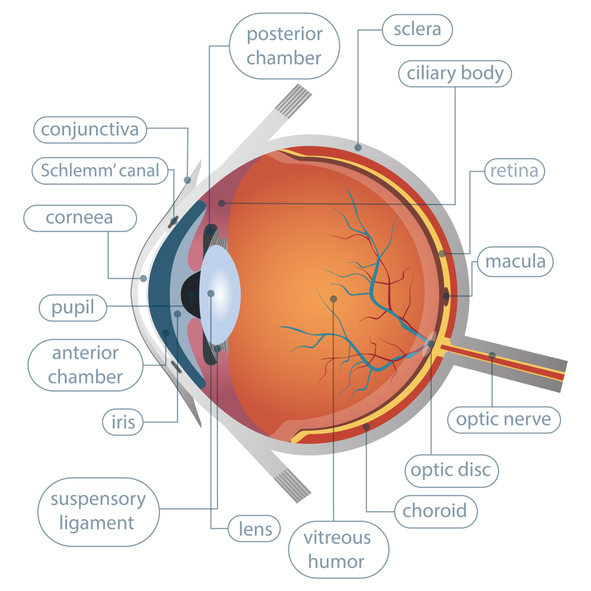Imagine God, in all His glory, when He created man. The intricate detail He put into every aspect of this beautiful life is astounding.
One particular part of the body that is especially intricate is the eye. The eye is composed of many moving parts and functions that most do not see its pure magnificence. Because of its complexity and the unlikeliness of it being created by evolution, the eye displays evidence of intelligent design.
the basic facts
Although the eye is very small, just one four-thousandth of an adult’s weight, about 80% of information processed is through the eye. According to John Blanchard, “the eyes can handle 50,000 messages simultaneously…” Not only are they computing messages, but tear ducts also are working to produce the right amount of fluid to properly protect the eye in just one five-thousandth of a second. This shows that even for something as simple as the process of protecting the eye, it is still very complex.
The outermost layer of the eye is the cornea. It gets its food and oxygen from tears, which lubricate the cornea and kill bacteria. This is an example that many parts of the eye work together in order to perform the way they are designed. When the eye first encounters light, it passes through the crystalline lens, which is located behind the pupil, and it has no color. This lens helps to focus the light coming into the retina, which then transforms light signals into electronic messages to the brain. After going through the lens, light then travels through a jelly-like tissue called the vitreous humor before it reaches the retina. Due to the spherical shape of the lens, the projected light images are distorted, but our fast brain corrects these distortions, giving us a perfect image.
After light has passed through the cornea and the lens, it is processed in the retina which transforms the light into an electric signal through complex structures in its system using rods and cones, then this signal is transmitted to the brain through the optic nerve. According to Ker Than, “Rods are used for monochrome vision in poor light, while cones are used for color and for the detection of fine detail.” There are about 130 million rods and 6 million cones in the eye. With these systems, people are able to see. Interestingly, rods without cones would be useless to us and vice versa because God has designed the eye to work in perfect harmony together.
In order to simplify the processes by which the eye sees, many have related it to a modern day camera. Bibleprobe.com says, “(the eye) is like the top-of-the-line modern camera…having a self-adjusting aperture, an automatic focus system, and inner surface surrounded by dark pigment to minimize the scattering of stray light.” Another man by the name of Alan L. Gillen states, “the best camera film can handle a ratio of 1000-to-1 photons in terms of light intensity. By comparison, human retinal cells can handle a ratio of 10 billion-to-1…” This states that the complexity of the modern day camera is nothing compared to the beauty and complexity of the eye. The sensitivity of an eye is so great it adjusts, “10 billion fold to changes in brightness,” says bibleprobe.com. With these facts in mind, this question can be asked, “How can a God not have created the eye?”
With all these amazing parts of the eye there is one small but major part; the muscles. The ciliary muscles either contract or relax to enable the eye to see far away or up close (relax-see objects far away, contract-see objects up close.) There are six main muscles in the eye that work to make it move smoothly. Four of the muscles account for the eye’s horizontal and vertical movement, and two of the muscles account for the rotation of the eye. Another amazing function of the eye is a process called Saccadic masking (sa-kah-dik.) Without this important process, the movement of the eye from side to side would cause nausea and dizziness. Its basic function is to cut out our vision when the eye is moving. Because of this, people are blind for approximately 40 minutes per day. By standing in front of a mirror, looking side to side, saccadic masking can be “seen.” One will not be able to see his eyes move because of this.
By looking at simple scientific facts and the structures and processes of the eye, it can be seen that there is indeed a Creator who orchestrated our vision.
layers of evidence
To find evidence of intelligent design, first take a look at how natural selection says the eye was formed. According to National Geographic, “(it is) the process by which genetic traits are passed on to each successive generation. Over time, natural selection helps species become better adapted to their environment. Also known as “survival of the fittest.” The main basis of natural selection is that change takes place over time from a series of mutations. A change in natural selection occurs when certain organisms or structures have a greater survival rate than others, and a mutation that is not immediately helpful to the organism will die off.
It can be inferred that the eye was formed by mutations according to the theory of natural selection. The problem with natural selection is that it does not keep any mutation or change that is not immediately functional, so to suppose that the eye and all its intricate parts came from millions of mutations, is very far fetched. A mutated retina would not survive or live without the lens, and a mutated lens would not survive or live without the retina.
According to biologist Laurence R. Croft, “the precise origin of the vertebrate eye is still a mystery.” This is no mystery for those who believe in the Creator of all things, God. Paul Ehrlich argues for intelligent design, “Because mutations are random relative to need and because organisms generally fit well into their environments, mutations normally are either neutral or harmful; only very rarely are they helpful—just as random change made by poking a screwdriver into the guts of your computer will rarely improve its performance.”
How could the eye, and all its complexity, be formed from a random succession of events? Intelligent design says that the parts of the universe and nature are best explained by intelligent cause. The eye fits this exact definition. An intelligent being has to create an intelligent structure, not a random mutation creating random components of the eye.
Even Charles Darwin said, “To suppose that the eye, with all its inimitable contrivances for adjusting the focus to different distances, for admitting different amounts of light, and for the correction of spherical and chromatic aberration, could have been formed by natural selection, seems, I freely confess, absurd in the highest degree.”
Finally, the eye shows intelligent design because its immense structures and systems purely could not have been made by a series of random events. The eye was planned, and it was made by God. He thought of the system of “Saccadic masking” to better help our vision. He thought of tears to wet our eyes and rid them from all the dirt inside.
One might say mutations that occurred in a certain order created the eye, but a mutation only stays if it is immediately helpful. All of the parts of the eye have to work together, at the same time, in order for it to function, and God did just that in one day, the sixth day of creation. Although evolutionists still argue that the eye was created through a series of mutations, one thing can be “seen” about the eye, no matter how much one studies it, there’s no denying its intricacy and complexity.
Great are the works of the Lord; they are pondered by all who delight in them. —Psalm 111:2
Kylie Wehling is a first year student at Campion Academy in Loveland, Colorado.
Resources
- Bergman, Jerry. “Did Eyes Evolve by Darwinian Mechanisms?” Creation.com | Creation Ministries
International, creation.com/did-eyes-evolve-by-darwinian-mechanisms.
- Bergman, Jerry. “The Human Retina Shows Evidence of Good Design.” Answers in Genesis, 8 June 2011,
answersingenesis.org/human-body/eyes/the-human-retina-shows-evidence-of-good-design/.
- “Darwin, Evolution, & Natural Selection.” Khan Academy, Khan Academy,
www.khanacademy.org/science/biology/her/evolution-and-natural-selection/a/darwin-evolution-natural-selection.
- “Irreducible Complexity and Michael Behe.” Irreducible Complexity and Michael Behe on Intelligent Design,
www.talkorigins.org/faqs/behe.html.
- Keohane, Steve. The Human Eye – Another Case for Creationism, www.bibleprobe.com/humaneye.htm.
- “Natural Selection: How Evolution Works.” ACTION BIOSCIENCE,
www.actionbioscience.org/evolution/futuyma.html.
- Peshin, Akash. “What Is Saccadic Masking?” Science ABC, Science ABC, 18 July 2018,
www.scienceabc.com/humans/what-is-saccadic-masking.html/.
- Purdom, Georgia. “Is the Intelligent Design Movement Christian?” Answers in Genesis, 6 May 2010,
answersingenesis.org/intelligent-design/is-the-intelligent-design-movement-christian/.
- Richardson, Taylor. “Seeing Is Believing: The Design of the Human Eye.” ApologeticsPress.org,
apologeticspress.org/apcontent.aspx?category=9&article=1412.
- Sherwin, Frank. “The Eyes of Creation.” The Institute for Creation Research,
www.icr.org/article/eyes-creation/.
- “The Complex System of the Eye.” Creation Studies Institute,
www.creationstudies.org/articles/who-is-god/272-complex-eye.
- “What Is Intelligent Design?” What Is Intelligent Design? | Intelligent Design, intelligentdesign.org/whatisid/.










